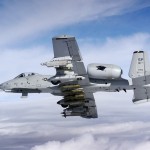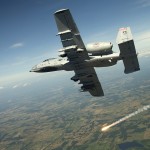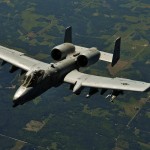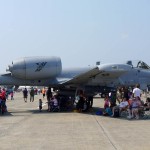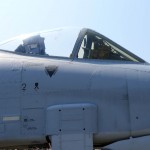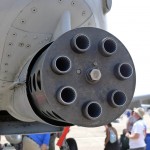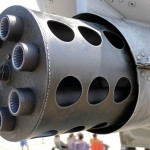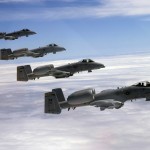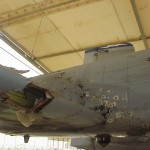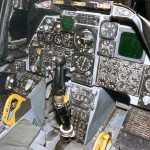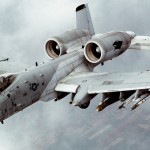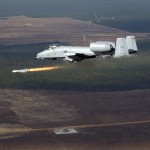
Go ugly early.
That’s what they say on the ground. Some might call the A-10 ugly, but to the men and women on the ground, it’s a thing of beauty. You want it there, early, to provide support during a battle. It’s big, super-armored, carries tons of weapons, and has a machine gun that can blow up a tank.
We leave the datestamps on our encyclopedia entries in order to keep the information currant. In our early Air Cache reboot days, we have done a lot of work around close air support. It’s a concept that all major military powers have recognized. We covered Brazil, China, and the former Soviet Union. But the A-10 “Thunderbolt II” is the king. It has the avionics, low-altitude performance, armor, and weapons that put it aside in its group. The Soviet-era Su-25 “Frogfoot” has the weapons, but lacks maneuverability and armor. The Brazilian/Italian AMX has the advanced systems, but lacks the firepower of the A-10. The Chinese Q-5 “Fantan” shows its 40+ year-old age with 60s-era systems.
The A-10 is more commonly called the “Warthog.” It did not come into its own until the 1990s. Before that, the U.S. Army relied on helicopters for ground attack missions. But choppers are very slow, have limited range, and tend to be delicate — even susceptible to small arms fire from the ground. Then came the Persian Gulf War. The A-10 had its chance and maximized it, destroying 900 Iraqi tanks, 2,000 vehicles, and 1,200 pieces of artillery. It even had two air-to-air kills. A few were shot down by surface-to-air missiles, but the A-10 had a mission capable rate of 95.7 percent, forcing the Air Force to hastily abandon its plans for the A-16, a ground attack version of the F-16 “Fighting Falcon.”
A-10s have fought in every major American conflict in the last 20 years, including Bosnia, Kosovo, Iraq, Afghanistan, and Libya.
In the mid 2000s, the Air Force had slotted the A-10 for retirement in 2028, to be replaced by the new F-35, but those plans have been scrapped, extending the “Hog’s” life indefinitely. A total of 716 have been built, with the last A-10 rolling off the line in 1984. A series of systems and weapons upgrades have been made ever since.

The A-10 does not even need missiles or bombs to be effective — though it carries plenty. The plane is essentially built around its massive GAU-8/A “Avenger” cannon. The “Avenger” is a 7-barrelled 30 mm cannon that fires heavy depleted uranium shells. The gun can destroy a tank. It is the size of a car and represents most of the A-10’s forward weight. It has so much force, that its recoil actually slows the airplane down. It is an effective weapon, but there is some controversy surrounding the use of depleted uranium in weapons because of possible effects on the nearby environment and health risks to civilian populations.
The A-10 also carries the AGM-65 Maverick air-to-surface missile, giving it extended range beyond its cannon. It can also carry iron bombs and can technically carry laser-guided bombs, but it rarely does. For self-defense, the A-10 also carries a pair of AIM-9 “Sidewinder” missiles and a decoy or ECM pod. The A-10 is perceived as low tech (it was actually featured as a human resistance plane in the movie “Terminator Salvation,” where the last remnants of humanity battle a computer system that has taken over the world) but it’s more advanced than it seems. The A-10C variant features a glass cockpit, and upgrades to the A-10 program include a data link, GPS navigation, and modern targeting and weapons systems.
Vitally, especially for an aircraft that can’t exceed 518 mph, the A-10 is thickly armored. It is designed to take massive damage and remain flyable. It can survive hits from armor-piercing and high-explosive projectiles up to 23 mm. It has triple-redundant mechanical and hydraulic systems and can fly with pieces of a wing missing. It can also fly with an engine out, a tail missing, and one of its elevators missing. It can manually deploy landing gear using hinges and gravity or just belly land if the need arises.

Proof of concept came in 2003, during the invasion of Iraq. The A-10 flown by Captain (now Major) Kim “Killer Chick” Campbell came under anti-aircraft artillery fire after a mission over Baghdad on April 7.
“We did our job with the guys there on the ground, and as we were on our way out is when I felt the jet get hit. It was pretty obvious — it was loud… I lost all hydraulics instantaneously, and the jet rolled left and pointed toward the ground, which was an uncomfortable feeling over Baghdad. It didn’t respond to any of my control inputs,” she later said.
She put the plane in manual reversion mode and carefully flew the plane for a half hour back to base and landed safely without hydraulics, brakes, or steering. It was later determined that her A-10 had a damaged engine, damage to the redundant hydraulics, hundreds of holes in the airframe, and large sections of a wing and stabilizer missing.
Campbell was awarded the Distinguished Flying Cross for her actions that day.
As of May 2012, the Air Force has 343 A-10s in service: 187 in active service, 49 in the reserve, and 107 in the Air National Guard.
Specifications
General
Crew: One
Length: 53 ft 4 in
Wingspan: 57 ft 6 in
Height: 14 ft 8 in
Empty weight: 24,959 lb
Max. takeoff weight: 50,000 lb
Engines: Two General Electric TF34-GE-100A turbofans, 9,065 lbf each
Performance
Never exceed speed: 518 mph
Maximum speed: 439 mph
Stall speed: 138 mph
Combat radius: About 290 mi
Ferry range: 2,580 mi
Ceiling: 45,000 ft
Rate of climb: 6,000 ft/min
Thrust/weight: 0.36
Armament
Guns: 30 mm GAU-8/A Avenger cannon with 1,174 rounds
Hardpoints: 11 with a capacity of 16,000 lb to carry:
-
Rockets:
- LAU-61/LAU-68 rocket pods
- LAU-5003 rocket pods
- LAU-10 rocket pods
-
Missiles:
- 2× AIM-9 Sidewinders air-to-air missiles
- 6× AGM-65 Maverick air-to-surface missiles
-
Bombs:
- Mark 80 iron bombs
- Mk 77 incendiary bombs
- BLU-1, BLU-27/B Rockeye II, Mk20, BL-755 or CBU-52/58/71/87/89/97 cluster bombs
- Paveway laser-guided bombs
- Joint Direct Attack Munition (A-10C)
- Wind Corrected Munitions Dispenser (A-10C)
Essential Reading and More
Online Resources:
- Wikipedia
- U.S. Air Force Official Factsheet
- Warthog News — Active blog with good Facebook/social media presence
- Warthog Territory — Dated site, but great photos and an active message board
- Boeing — Official site
- Hogs of War — Blog dedicated to the A-10 in video games
